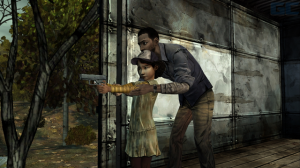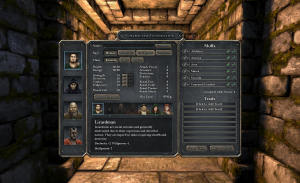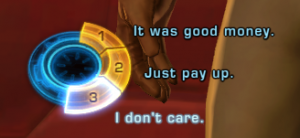This is the second in a (very occasional) series of articles dissecting challenges and techniques in game narrative. The first, “Developing Meaningful Player Character Arcs in Branching Narrative,” originally appeared on Gamasutra and is linked from this blog. Shorter game writing missives are available via the Video Game Writing category.
Let’s start with a bold statement and riddle it with clarifications and exceptions as we go:
The more I care about a game’s viewpoint character, the less I care about every non-player character in the game.
The converse–the less I care about a game’s viewpoint character, the more I care about the non-player characters–is basically true as well, albeit with a few more exceptions.
This is a feature, not a bug. It is a tool game writers should use to build powerful stories, not something to work around.
Shall we talk about what it means?
Viewpoint Characters in Video Games
On a basic level, we can break down point of view “characters” (who aren’t always characters, as we’ll get to) in video games into three large, messy categories: total ciphers, fully defined characters, and player-influenced characters.
Total Ciphers. These are characters who don’t speak, who don’t have personalities, who may not even have the most basic of motivations. They exist as a medium through which the player interacts with the game world. First-person shooter protagonists often fall into this category–but then again, so do text adventure protagonists. The vast majority of strategy games (real-time strategy and turn-based) use these sorts of characters. Abstract games like Tetris, while clearly lacking a point of view “character” in any traditional sense, would fall into this category as well.
With a cipher, players are likely to feel ownership but not a great deal of empathy. That is, players will care about what becomes of the character (particularly on a game mechanics level), but not put a lot of stock in that character’s thoughts or inner life. Clever writing can ameliorate this to an extent–if other characters repeatedly ask about what the viewpoint character is thinking, question his or her motives, and so forth, it can push the cipher closer to another category–but this isn’t always desirable.

Possessing a name, appearance, and snippets of background, viewpoint character Katie of “Gone Home” isn’t quite a total cipher… but she’s pretty close. Then again, “Gone Home” clearly isn’t her story.
Fully Defined Characters. These characters have clear personalities and little room for player customization. They resemble characters from traditional storytelling media–you could transplant Lara Croft or Gabriel Knight into a novel or screenplay without great difficulty, whereas doing so with the cipher protagonist of the original StarCraft or Adam Jensen of Deus Ex: Human Revolution creates a host of difficulties.
Fully defined viewpoint characters tend to grant players a sense of empathy (when written well, anyway–bad writing is bad writing, and carefully thought-out viewpoint choices won’t change that) but not a great sense of ownership. I may want to understand a fully defined viewpoint character’s heart and soul, but I don’t feel like I have much choice in what’s going on inside her brain. When I lose control over such a character in a cutscene, even if the character does something I disapprove of, it doesn’t bother me as much from a narrative perspective–the character isn’t mine anyway.
Player-Influenced Characters. These characters are typical of Western role-playing games–characters who typically have some degree of personality, some sort of visual representation, and some level of speaking role, but who are also malleable to the player’s intent through choice and game mechanics–that is, I may select my gender, build my appearance, choose dialogue options reflecting motivations, etc.
The reality is nuanced, of course–while Fallout’s nameless Vault Dweller and the voiceless Gray Warden of Dragon Age: Origins resemble the wide-open cipher in some respects, Mass Effect’s Commander Shepard drifts toward fully defined at times with a narrower range of personality options. (I strongly suspect, if polled, a majority of players would pick Shepard as their favorite Mass Effect character–whereas a similar poll for Dragon Age: Origins would likely result in a non-player companion character being chosen.) Still, it’s a useful category for purposes of our discussion.
Player-influenced viewpoint characters tend to mix ownership and empathy together to create the strongest bond between player and character. I’m deeply invested in a player-influenced character, and I also empathize and understand his emotions.
Note that these viewpoint types aren’t wedded to literal viewpoints (i.e., camera modes). While many first-person game viewpoint characters are ciphers, there are plenty of counterexamples (The aforementioned Adam Jensen or the fully-customizable protagonist of Vampire: The Masquerade – Bloodlines, for example). Third-person games often have fully defined characters, but most MMORPGs present examples of ciphers in this camera mode.
Empathy and Sympathy
Knowing how much players care about and empathize with different types of viewpoint characters, we can consider what this means for how players relate to non-player characters.
When it comes to player-influenced viewpoint characters–characters I deeply empathize with and feel a close connection to, whose growth and change I’m responsible for–we’re looking at a situation closest to the real world. When I look at non-player characters, I’m doing so through the lens of my own experiences and in the context of my character’s needs. My viewpoint character is the absolute center of my world.
As a result, my feelings for non-player characters are dependent on my relationship to them. Two characters talking about something my character isn’t personally invested in? Boring. A character I don’t know well telling me about her past traumas? Difficult to relate to. On the other hand, a non-player character I’ve spent time with, befriended, and come to know gets a lot more leeway–like a real-world friend, I care about what she’s going through even if it doesn’t affect me directly. Generally speaking, I care about other characters in regards to their relationship to the viewpoint character and resent being upstaged.

A touching moment of bonding with an NPC. Was it earned? “The Walking Dead” screenshot taken by user BanishU at the Walking Dead Wiki.
Fully defined viewpoint characters, as mentioned above, most resemble characters found in traditional media. With a fully defined viewpoint character, players are pushed to see the game world and characters more objectively–as opposed to the subjective, “inside the character’s head” viewpoint of the player-influenced character. As a player, my focus is still on the viewpoint character at a level untrue of traditional media, of course–there’s still the risk of being upstaged, and a host of game-specific narrative techniques that must be minded–but my decreased sense of ownership means that time and emotion spent on non-player characters doesn’t detract from the core experience to the same extent. I have the luxury of sympathizing with other characters and developing an interest in their stories, because it’s clear that “my” story doesn’t actually belong to me.
Many traditional media rules are still applicable. A film or novel that wanders from its main character or doesn’t allow its protagonist agency is likely to lose an audience’s attention, and the same remains true of games to an even larger extent. But that difference is one of degree, rather than kind.
Total ciphers force the emotional weight of a game’s storyline onto non-player characters, and the player’s sympathy will typically gravitate to such characters naturally. There’s a reason why “audio logs” (as popularized in System Shock and used in so many first-person games thereafter) are an effective storytelling device for first-person shooters with cipher viewpoint characters–players are starved for characters to connect to in the game world, and logs are a cheap and direct solution.
To reiterate the trend–the more I care about the viewpoint character, the more difficult it is to make me care about non-player characters. Those connections have to be built, earned, and carefully maintained. The less I care about the viewpoint character, the easier it is to make me care about others. This isn’t an end result–it’s a baseline, and writing quality and game design can dramatically shift the outcome–but it’s vital to planning one’s approach and assessing problems.
Practical Applications
So how can we apply this knowledge when designing game stories? Consider what characters and character relationships are most important to your game, and how that affects your viewpoint character (and vice-versa). If you want the core of your story to be the developing relationship between your viewpoint character and a non-player character, your easiest approach will likely be with a fully defined protagonist… but easiest isn’t always best, and other approaches are possible and rewarding if you’re mindful of the challenges. If your story is largely about the emotional struggle and development of a non-player character, it’s very likely you don’t want a player-influenced viewpoint character–again, unless you’re very sure of what you’re doing and confident you can meet the challenges.
As a general rule of fiction, of course, it’s best to make your viewpoint character the character with the most at stake, who has the most agency and is the most active in striving to accomplish her goals. But plenty of great fiction breaks this rule, and you can break it in games, as well–but do so carefully, and make sure your quality of writing hits the required bar to pull it off. (There’s no shame in deciding, “This can be done, but we don’t have the skills–or possibly the appetite for risk–to do it.”)
In other words, if your viewpoint character isn’t the clear protagonist of the story, then you may want to rethink that. If you’re sure of yourself, then you should consider how everything we’ve discussed affects the design of your viewpoint character.
There are also countless complications to be addressed on an advanced level. Consider the following:
What effect does voiceover have on player attachment, empathy, and ownership? For a long time, role-playing games tended to give non-player characters voices without voicing the player. This has changed dramatically in the past decade, but voiceover is one of a number of dials that can be adjusted for the desired outcome.

The player controls a party of four characters in “Legend of Grimrock.” What are the viewpoint implications?
What about games with multiple viewpoint characters? Party based games in which the player controls an entire group at once have a long tradition in role-playing games, strategy games, and squad-based shooters. One could argue that the viewpoint character here is, in fact, an invisible cipher–a player surrogate controlling the other playable characters. And of course, the individual party members may range anywhere on the spectrum from cipher to fully defined to player-influenced as well, leading to further complications and fascinating possibilities.
And then again, we have games in which the viewpoint character changes. This may be from level to level or map to map, or the switch may be player initiated; each of these mechanics has its own implications, good and bad.
No game exists as a perfect theoretical model, and designers should be encouraged to experiment with the nature of player viewpoint characters–but to do so with an understanding of the baseline we’ve discussed. Compelling character concepts and dialogue are ultimately meaningless in a game that doesn’t account for the unique nature of viewpoints, empathy, and sympathy in game writing; if we apply the lessons of the wrong medium to interactive storytelling, we’re denying our audience the narratives they deserve.
As always, debate and rebuttals are welcome–get in touch via the Contact page and let me know if you see matters differently, and I’ll gladly post alternative takes here.

